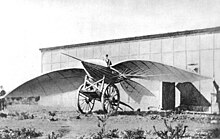History
Antecedents
Many stories from antiquity involve flight, such as the Greek legend of Icarus and Daedalus, and the Vimana in ancient Indian epics. Around 400 BC in Greece, Archytas was reputed to have designed and built the first artificial, self-propelled flying device, a bird-shaped model propelled by a jet of what was probably steam, said to have flown some 200 m (660 ft).[11][12] This machine may have been suspended for its flight.[13][14]
Some of the earliest recorded attempts with gliders were those by the 9th-century poet Abbas ibn Firnas and the 11th-century monk Eilmer of Malmesbury; both experiments injured their pilots.[15] Leonardo da Vinci researched the wing design of birds and designed a man-powered aircraft in his Codex on the Flight of Birds (1502).
In 1799, George Cayley set forth the concept of the modern airplane as a fixed-wing flying machine with separate systems for lift, propulsion, and control.[16][17] Cayley was building and flying models of fixed-wing aircraft as early as 1803, and he built a successful passenger-carrying glider in 1853.[5] In 1856, Frenchman Jean-Marie Le Bris made the first powered flight, by having his glider "L'Albatros artificiel" pulled by a horse on a beach.[18] Then Alexander F. Mozhaisky also made some innovative designs. In 1883, the American John J. Montgomery made a controlled flight in a glider.[19] Other aviators who made similar flights at that time were Otto Lilienthal, Percy Pilcher, and Octave Chanute.
Sir Hiram Maxim built a craft that weighed 3.5 tons, with a 110-foot (34 m) wingspan that was powered by two 360-horsepower (270 kW) steam engines driving two propellers. In 1894, his machine was tested with overhead rails to prevent it from rising. The test showed that it had enough lift to take off. The craft was uncontrollable, which Maxim, it is presumed, realized, because he subsequently abandoned work on it.[20]
In the 1890s, Lawrence Hargrave conducted research on wing structures and developed a box kite that lifted the weight of a man. His box kite designs were widely adopted. Although he also developed a type of rotary aircraft engine, he did not create and fly a powered fixed-wing aircraft.[21]
Between 1867 and 1896, the German pioneer of human aviation Otto Lilienthal developed heavier-than-air flight. He was the first person to make well-documented, repeated, successful gliding flights.
Early powered flights
Clement Ader constructed his first of three flying machines in 1886, the Éole. It was a bat-like design run by a lightweight steam engine of his own invention, with four cylinders developing 20 horsepower (15 kW), driving a four-blade propeller. The engine weighed no more than 4 kilograms per kilowatt (6.6 lb/hp). The wings had a span of 14 m (46 ft). All-up weight was 300 kilograms (660 lb). On 9 October 1890, Ader attempted to fly the Éole. Aviation historians give credit to this effort as a powered take-off and uncontrolled hop of approximately 50 m (160 ft) at a height of approximately 200 mm (7.9 in).[22][23] Ader's two subsequent machines were not documented to have achieved flight.[24]
The Wright brothers flights in 1903 are recognized by the Fédération Aéronautique Internationale (FAI), the standard setting and record-keeping body for aeronautics, as "the first sustained and controlled heavier-than-air powered flight".[4] By 1905, the Wright Flyer III was capable of fully controllable, stable flight for substantial periods. The Wright brothers credited Otto Lilienthal as a major inspiration for their decision to pursue manned flight.
In 1906, Alberto Santos-Dumont made what was claimed to be the first airplane flight unassisted by catapult[25] and set the first world record recognized by the Aéro-Club de France by flying 220 meters (720 ft) in less than 22 seconds.[26] This flight was also certified by the FAI.[27][28]
An early aircraft design that brought together the modern monoplane tractor configuration was the Blériot VIII design of 1908. It had movable tail surfaces controlling both yaw and pitch, a form of roll control supplied either by wing warping or by ailerons and controlled by its pilot with a joystick and rudder bar. It was an important predecessor of his later Blériot XI Channel-crossing aircraft of the summer of 1909.[29]
World War I served as a testbed for the use of the airplane as a weapon. Airplanes demonstrated their potential as mobile observation platforms, then proved themselves to be machines of war capable of causing casualties to the enemy. The earliest known aerial victory with a synchronized machine gun-armed fighter aircraft occurred in 1915, by German Luftstreitkräfte Leutnant Kurt Wintgens. Fighter aces appeared; the greatest (by number of Aerial Combat victories) was Manfred von Richthofen.
Following WWI, aircraft technology continued to develop. Alcock and Brown crossed the Atlantic non-stop for the first time in 1919. The first international commercial flights took place between the United States and Canada in 1919.[30]
Airplanes had a presence in all the major battles of World War II. They were an essential component of the military strategies of the period, such as the German Blitzkrieg, The Battle of Britain, and the American and Japanese aircraft carrier campaigns of the Pacific War.
Development of jet aircraft
The first practical jet aircraft was the German Heinkel He 178, which was tested in 1939. In 1943, the Messerschmitt Me 262, the first operational jet fighter aircraft, went into service in the German Luftwaffe. In October 1947, the Bell X-1 was the first aircraft to exceed the speed of sound.[31]
The first jet airliner, the de Havilland Comet, was introduced in 1952. The Boeing 707, the first widely successful commercial jet, was in commercial service for more than 50 years, from 1958 to 2010. The Boeing 747 was the world's biggest passenger aircraft from 1970 until it was surpassed by the Airbus A380 in 2005.






No comments:
Post a Comment